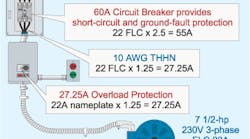Understanding the overcurrent trilogy will help you protect your circuits.
Circuit overcurrent protection encompasses overload, short-circuit, and ground-fault protection. NEC Art. 100 defines overcurrent as any current in excess of the rated current of the equipment or the ampacity of a conductor. Overload is the operation of equipment in excess of full-load rating where, if it persists for too long, it would cause damage or dangerous overheating. A short circuit or ground fault isn't an overload even though it's an overcurrent condition.
The time it takes for an overcurrent protection device (OCPD) to open is inversely proportional to the magnitude of the fault current. Thus, the higher the ground-fault current, the less time it takes for the OCPD to open and clear the fault. For example a 30A circuit with an overload of 60A would trip a breaker in 25 sec to 150 sec. At 150A the breaker would trip in 5 sec to 20 sec. If the overcurrent is from a short circuit or ground fault, say 300A, the 30A breaker should trip in less than 1 sec.
Typically, you must protect conductors against overcurrent in accordance with their ampacity (240.4). For example, you would protect a 10 AWG conductor such that it doesn't conduct more than 30A. But some applications involve more than one OCPD. In these situations, the NEC doesn't always require you to protect conductors in accordance with their ampacities. For example, the rules in 430.31 require you to provide OCPDs to protect motors, motor-control apparatus, and motor branch-circuit conductors against excessive heating from motor overloads and failure to start. Sec. 430.32 requires you to size the OCPD between 115% and 140% of the motor nameplate current rating.
Sec. 430.51, which addresses branch-circuit, short-circuit, and ground-fault protection, requires you to size the OCPD large enough so the motor branch-circuit, short-circuit, and ground-fault protective device can carry the motor starting current. To accomplish this with a breaker, you must size the protection at no more than 250% of motor full load current rating in accordance with 430.52. In most cases, you can't use one OCPD to provide all three forms of protection.
Consider, for example, a 7.5-hp, 230V, 3-phase motor with a nameplate current rating of 22A, and 22A FLC (Table 430.150) (see Figure above). You would size the conductor at 125% of motor FLC [430.22(A)]. This would be 27.25A (22A×1.25), thus requiring a 10 AWG conductor, per Table 310.16. A separate OCPD is sized no more than 27.25A (125% of motor nameplate current [430.32(A)(1)]). The short-circuit and ground-fault protection device must be sized no greater than 250% of motor full load current rating [430.52(C)(1) Ex. 1]. By multiplying 22A×2.5, you get 55A, but you need to select the next biggest size, which is 60A.
The NEC permits you to protect a motor against overload, short circuit, and ground fault with a single protection device, but you must size it per the overload rules in 430.32 [430.55]. For our example, you can use a 30A, dual-element fuse.
OCPDs can protect against overload, short circuit, and ground fault, but be careful, because in some cases, they don't address all three items.




